BY TARA KATIR
Ranging from a child’s yoga book to a series of essays investigating the scholarly and often emotional debate surrounding the Aryan migration hypotheses, our books this issue could hardly be more diverse. Little Yoga, A Toddler’s First Book of Yoga by Rebecca Whitford and Martina Selway is the sweetest place to begin our journey. Little Yoga is literally and figuratively a little book for little children and their mommies and daddies. In whimsical and colorful art depicting smiling tots in simple yoga poses, Whitford and Selway have delightfully captured the spirit of very young children. Posing and moving like butterflies, frogs, cats, dogs and birds while breathing like lions, young children are sure to find this book fun to share with their parents. Special sections for parents and caregivers have color photos of toddlers in each pose, a simple explanation of the poses and practical tips for making yoga simple and playful while teaching your child. Whether it’s for read-aloud or practice together, this little yoga book is a charmer.
Little Yoga, a Toddler’s First Book of Yoga, by Rebecca Whitford and Martina Selway, Henry Holt and Company, 115 west 18th Street, New York, New York 10011. us$9.95; 23 pages, http:/www.henryholt.com [http:/www.henryholt.com].
ROMANI HISTORY
Driven from India 1,000 years ago by Muslim armies, later to be enslaved in Europe, persecuted and derogatorily dubbed “Gypsies, ” the Romani people continue a unique culture with Hindu roots. Young people can explore this little-known past in History of the Romani People. The authors, Hristo Kyochukov, a Romani scholar at the University of Veliko, Bulgaria, and Ian Hancock, the director of The Romani Archives and Documentation Center, University of Texas in Austin, bring authenticity, grace and dignity to this lovely book. While small, it is filled with beautiful photographs, contemporary and archival, showing Romanies at work, play and intimate family gatherings. Beginning with the Romanies’ historical origins in India, subsequent defeat by invading Muslim armies and forced relocation westward, the authors trace the beginnings of the Romani nomadic migrations. Ending with life today, they note Romanies still face discrimination after centuries of persecution. Sadly, the European Court of Human Rights continues the discrimination by a recent ruling that allows the nearly automatic placement of Romani children in schools for the mentally handicapped. Romani language is related to Hindi. This is an appropriate book for parents and teachers to inspire respect and understanding for a people long maligned and misunderstood.
A history of the Romani People by Hristo Kyochukov and Ian Hancock, Boyds Mills Press, 815 Church St., Honesdale, Pennsylvania 18431. us$19.95; 32 pages, http:/www.boydsmillspress.com [http:/www.boydsmillspress.com].
DEBUNKING THE ARYAN THEORY
Our concluding book takes a most scholarly look at the debate surrounding the Indo-Aryan discussion. The Indo-Aryan Controversy, Evidence and Inference in Indian History, edited by Edwin F. Bryant and Laurie L. Patton, presents 13 essays by various scholars representing different points of view in the debate over the early history of India and surrounding the supposed “Aryan Invasion.” The essays address the issue within the context of three major areas: archaeological research in the relationships between the Indus Valley and the Aryan settlements; a linguistic look at the parent languages; the philological study and interpretation of Vedic texts in their historical context, an interpretation of astrological data and possible geographical influences. Ending with an historical assessment of current arguments and their various ideological roots, editor Bryant suggests the theories remain influenced by politics from the past as well as present. He points out there are many ways to interpret the evidence, which is hardly definitive in supporting theories of an Aryan invasion or migration. Most important is his analysis of the historical, social and political aspects of the debate. He says, for example, “I have expressed concern at what I have termed a type of Indological McCarthyism creeping into areas of Western, as well as certain Indian, academic circles, whereby anyone reconsidering the status quo of Indo-Aryan origins is instantly and a priori dubbed a nationalist, communal or, even worse, a Nazi.” He calls for a civil tone in the entire discussion: “There is all-too-often a mocking and condescending tone adopted by disputants of this issue, and a tendency of simply highlighting and ridiculing the most outlandish aspects of an opponent’s arguments while ignoring any coherent points that might counter one’s own position.” Be advised the essays are of uneven interest and quality and that the book as a whole is definitely a hard read. It is, however, useful information for anyone concerned with these unsettled historical issues.
The Indo-Aryan Controversy, Evidence and Inference in Indian History, edited by Edwin F. Bryant and Laurie L. Patton, Routledge, 270 Madison Ave., New York, New York 10016. US$43.95; 522 pages.


